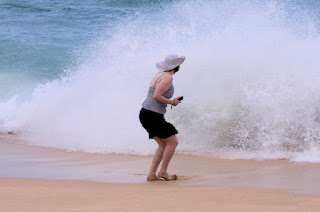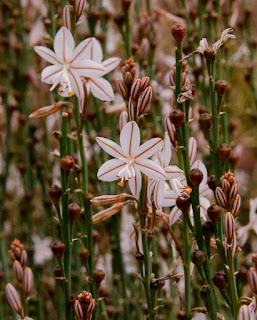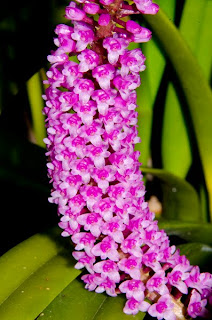Photos of birds, fish, flowers and miscellaneous things that catch my eye and instill a sense of wonder.
Monday, April 30, 2012
Will the Real Nemo Please Fin Up?
Amphiprion oscellaris, the Oscellaris Clownfish or False Percula Clownfish. Amphiprion oscellaris is closely related to Amphiprion percula, the Percula Clown or Orange Clown and, for most of us, is nearly indistinguishable. How do the ichthyoligists ("fish" scientists) tell them apart? The eyes on the percula clown are bright orange with a dark, clearly demarcated center, making their eyes look smaller. The eyes of the oscellaris clown are orange with a black pupil and shades into grey on parts of th iris (i.e., looks a little smudgy), giving the appearance of a larger eye. Oscellaris also have 11 dorsal spines while percula clowns have 10 dorsal spines. The eyes, however, are easier to spot, especially on a moving fish. So which one was Nemo? Well, Nemo was a cartoon so he can be anyone you wish. However, he had brighter colors and clearly demarcated eyes (I dare you to count dorsal spines and get back to us gentle readers...), so I'm guessing Nemo was a percula clown.
Note, if you're thinking of buying one, oscellaris clowns look plenty close enough for most kids to call them Nemo and are a little hardier. They are both from the Indo-Pacific, particularly near Fiji and Tongo, where they live in large sea anemones which serve as home and protection for their little clownfish friends. Note that the clownfish are also known to feed their anemone hosts in a somewhat symbiotic relationship, pushing food into the anemone's mouth.
Sunday, April 29, 2012
Bletilla striata alba
Bletilla striata alba (albescens?). This Bletilla is just coming into bloom in the yard. These hardy, terrestrial orchids can stand temperatures down to around 20F or lower, if mulched. These are growing in light shade in front of the greenhouse. They are native to China and Japan.
Saturday, April 28, 2012
Having It All
Common House Finch, hogging the entire bird food bowl, peeks up over the rim to keep an eye out for predators.
Thursday, April 26, 2012
Going dark for a day...
My Aunt passed away today. That makes four people I knew in the last year. She was the youngest and perhaps the feistiest of eleven children. She was a nurse and a contant caretaker for others in her life. I will always remember her as the one that bought Christmas presents for all of the nieces and nephews (and there were a lot of us) and then recruited us to help wrap them. She was the one that urged her other sisters to visit her elder sister, even though her sister was no longer able to tell that any of them were present. She was the one that helped clean and care for older friends. She seemed unstoppable. Even though she checked herself into a hospice, it seemed as if her strength of will would perservere and they would, at some point, have to evict her for living too long. However, sometimes, appearances are deceiving. Eventually, perhaps all too soon, death comes for even the most feisty of us, having sucked the marrow from the very bones until there was no more life to give and burned the flame so bright it hurt. May she rest in peace. Rest in peace.
Wednesday, April 25, 2012
Bluespine Unicornfish, Naso unicornis
Bluespine Unicornfish or Kala (Hawaiian), Naso unicornis, Waikiki, Hawaii. These huge, gentle fish are the cows of the sea, spending their days grazing on algae that would otherwise clog the coral reef and kill delicate corals. When threatened, they extend those large, knife-like spines on their tail, warding off would be predators.
Nenue (Hawaiian), Kyphosus vaigiensis or Lowfin Chub
Nenue (Hawaiian), Kyphosus vaigiensis or Lowfin Chub, outside of the reef at Queen's Surf, Hawaii. This sizeable fish reaches about 27 inches in length. It typically is found in schools of around 20+ individuals in reef/surge zones where it feeds on marine algae. These pictures were shot at about 3 ft. distance forcing me to zoom out the camera to capture more than one fish, given the large size of each individual fish. Luckily, a sizeable school of Nenue continued to swim past me for a few minutes, long enough to take multiple shots at different zoom settings.
Sunday, April 22, 2012
Saturday, April 21, 2012
Duck Yoga
Duck Yoga starring Just Duckie (left) demonstrating the Svarga Dvidasana and Duck for Cover (right) demonstrating the Eka Pada Sirsasana.
Friday, April 20, 2012
Shark Sighting in Waikiki
I was taking a quick dip with the underwater camera off Queen's Surf and was out just a little bit past the tip of the breakwater, perhaps 500 feet to the West. I saw some fins coming towards me in the distance and, as I moved in to get a better look and perhaps a photograph, I noticed that this fish was rather long and had large, pointy fins with, yes, white tips on them. About then, the light bulb goes off and I realize that this ia a white tipped reef shark (about 4 ft long), probably checking me out as I was trying to get some water out of my snorkle (glug, cough...). The shark turned left in through some large coral stands, I turned right, towards shore and the rest was history!
Brown Anole Trumps Green Anole!
Brown Anole, Anolis sagrei, doing its mating display on the wall at Gordon Biersch at the Aloha Tower in Honolulu. Brown Anoles are a Carribean species that have established themselves throughout the SE U.S. and are currently spreading rapidly throughout Hawaii. They are known to compete for the same food and also prey on the young of green/American Anoles, which they are largely displacing.
Super Fragrant Orchids
Dendrobium anosmum x Dendrobuim Super Nestor. These orchids are uber-fragrant in a sweet, perfumely sort of way and bloom with a dense profusion of flowers along the leafless canes.
Thursday, April 19, 2012
Spotted Puffer
Arothron meleagris, Spotted puffer, in about 5 feet of water off of Waikiki. Not the best angle but he promptly dove under a rock to avoid my pestering and there was too much silt in the water to use the flash (i.e. headlights in a snowstorm). Really cool fish and otherwise slow enough that you can get a close shot. This was the first time I've seen one of these in the water, so it was a small treat. They have sharp beaks that they use to crush the branching coral that they feed on. The relative scarcity of branching coral may be one of the reasons why they are fairly uncommon...
The Bird Man of Waikiki
This man holds out his hands with bread in them and the birds come...and come...and come until his arms are covered with birds!
Wednesday, April 18, 2012
Do Not Turn Your Back to the Waves
Tourist running from large waves, Sunset Beach, Hawaii. You never quite know when a big wave will come by, especially when you're facing the other way. This tourist, luckily, managed to neither get drenched nor swept out to sea, although her photo shoot was briefly interrupted...
Cordia subcordata or Kou Tree
Cordia subcordata, also known as the Mareer, Kerosene wood, Glueberry, Tou and Kou tree, is shown here in Kapiolani Park, Oahu. This beautiful, glossy-leaved, vibrantly orange-flowered tree, is native to eastern Africa, South Asia, Australia and the Pacific Islands. It is salt tolerant but not frost tolerant, its woody seeds floating long distances across the Pacific to germinate on far shores. Its fruit are apparently edible but not particularly flavorful, being occasionally eaten in times of famine. Its wood is soft, durable and easily carved, being historically used by the Hawaiians to make bowls, large calabashes (huge bowls), & utensils due to its ability to hold food without affecting the flavor of the food itself.
Tuesday, April 17, 2012
Double Rainbow Over Waikiki
Rainy morning over Waikiki. There were big warm drops of tropical rain falling from the sky, being whipped lightly by the ocean breeze. As I wondered somewhat retrospectively if I should have covered the lens on the SLR, a glorious double rainbow shone brightly over the ocean, somehow making it all a new, exciting adventure.
Monday, April 16, 2012
Sunset Beach
Surfer, Sunset Beach, Hawaii. The waves were not quite as big as during Winter but they were still fairly impressive.
Sunday, April 15, 2012
Saturday, April 14, 2012
Up Close and Iris
Iris Petal, up close. Note that the lower petal acts as a landing pad for insects looking for nectar within (the perianth). In the process any pollen the insect was carrying is applied to the stigmatic surface (receptive surface) while new pollen is applied to the hapless insect when it backs out. Thus, not only does the insect pollinate the iris, but flower structure is uniquely designed such that the flower is CROSS-pollinated; i.e., fertilized with pollen from a different flower.
Friday, April 13, 2012
Ring-necked Duck, Aythya collaris
The Ring-necked Duck, Aythya collaris, lives near wooded lakes and ponds in North America, where it feeds on water plants, bugs, molluscs and fish.
Wednesday, April 11, 2012
Onion Weed: Asphodelus fistulosus
Onion Weed, Asphodelus fistulosus, is an annual that is native to the Mediterranean region. However, it has become naturalized in California, Texas, Arizona and New Mexico where it has become, in some locations, an invasive weed. It favors sandy soils and Mediterranean climates. This Onion Weed was growing quite well on a sandy slope in the San Pasqual Valley where it made quite an impressive display.
Tuesday, April 10, 2012
The Tailed Jay or Graphium Agamemnon
The Tailed Jay or Graphium Agamemnon is a member of the swallowtail family that is found throughout Southeast Asia, Southern China, the South Pacific and Australia. The adults feed on nectar from flowers such as Lantana and Ixora while the caterpillars are hosted on Polyalthia longifolia trees and shrubs.
Monday, April 09, 2012
Leather Coral, Sarcophyton species
Leather Coral, Sarcophyton species. Leather corals are a little less fussy when compared to hard corals (i.e., those with a hard skeleton that build reefs). They tend to be less particular about water temperature and quality, often coming from sheltered lagoons versus open waters. They also tend to have larger, more visible polyps that often sway in the current in a very graceful, hypnotic manner. Some get reasonably large and will even serve as alternate homes for anemone fish when there are no anemones present. Leather corals come in a wide assortment of colors, shapes and forms and, if split, will (in good conditions) develop into multiple complete corals. Finally, note that leather corals exude chemicals that will damage other competing coral species that they come in contact with and generally do best with a little space between them.
Sunday, April 08, 2012
Paper Kite Butterfly or Large Tree Nymph, Idea leuconoe
Paper Kite Butterfly or Large Tree Nymph, Idea leuconoe. This butterfly hails from SE Asia where it is occasionally exported for live butterfly displays.
Saturday, April 07, 2012
Hooked Mallard, the Hazards of Monofilament Fish Line
Mallard, apparently hooked on some monofilament. This mallard has apparently ingested a fish line, probably with a hook at the other end. It's possible that he went after someone's bait but equally likely that some shiny fishing lure or fake worm remained on the river bottom, tempting this poor Mallard into what will probably be a death sentence, if it is not removed. Ironically, I did not notice the monofilament until I looked at the picture on the computer some days later.
Friday, April 06, 2012
Arpophyllum giganteum
Arpophyllum giganteum. These flowers are non-resupinate, i.e., they bloom with their lip up as opposed to most other orchids that bloom with their lip down. The flowers are born in huge numbers on sturdy, upright stems. This orchid is fairly widespread throughout Sourthern North America, South and Central America including Mexico, Guatemala, Belize, El Salvador, Honduras, Nicaragua, Costa Rica, Colombia, Venezuela and Jamaica where it grows in foothill forests.
Clematis x cartmanii 'Blaaval'
Clematis x cartmanii 'Blaaval' creates a profusion of large, glistening, white blossoms on a fast growing vine that is perfect for trellis or wall. It is hardy through zone 7 and requires regular water.
Wednesday, April 04, 2012
American Orchid Society San Diego Awards - March 3, 2012
Cattleya mossiae 'Kimberly Burzell' HCC/AOS 75pts
(Bllra. Tahoma Glacier x (Oda. Toroma x Oda. Ingera))'Smile Eri' AM/AOS 80pts
Cym Moondog Memory 'Makes Me Happy' HCC/AOS 75pts
Cyr. Shirley Dunkelberger AM/AOS 80pts
Lc (Tokyo Magic x Culminant) AM/AOS 81pts
Masd ignea AM/AOS 81pts
Sarcoglottis sceptrodes 'Loren' AM/AOS 81 pts
Slc. (Fire Fantasy X Bright Circle) AM/AOS 80pts
There were eight awards granted at Balboa Park at the March 3, 2012, Pacific South Region, American Orchid Society Judging Session. That's a pretty uncommon occurance. Perhaps it was a small tribute to our friend and fellow judge, Loren Batchman, who for so many years tirelessly chaired the region and could reliably be counted on to share a carton of donuts and some fresh produce from his yard. May he rest in peace.
** Note: not all of the exhibitors had given their plants clonal names at the time the photos were taken.
(Bllra. Tahoma Glacier x (Oda. Toroma x Oda. Ingera))'Smile Eri' AM/AOS 80pts
Cym Moondog Memory 'Makes Me Happy' HCC/AOS 75pts
Cyr. Shirley Dunkelberger AM/AOS 80pts
Lc (Tokyo Magic x Culminant) AM/AOS 81pts
Masd ignea AM/AOS 81pts
Sarcoglottis sceptrodes 'Loren' AM/AOS 81 pts
Slc. (Fire Fantasy X Bright Circle) AM/AOS 80pts
There were eight awards granted at Balboa Park at the March 3, 2012, Pacific South Region, American Orchid Society Judging Session. That's a pretty uncommon occurance. Perhaps it was a small tribute to our friend and fellow judge, Loren Batchman, who for so many years tirelessly chaired the region and could reliably be counted on to share a carton of donuts and some fresh produce from his yard. May he rest in peace.
** Note: not all of the exhibitors had given their plants clonal names at the time the photos were taken.
Monday, April 02, 2012
How Do They Propagate Those Brightly Colored Cacti?
Cactus sports or monsters are mutations that, in this case, contain no chlorophyll. They are propagated by cutting, which is grafted onto a green, photosynthesizing base.
Sunday, April 01, 2012
In Bloom: Nemsia fruticans
Nemsia fruticans is a small, perennial shrub native to South Africa where it's erstwhile mauve flowered ancestors grow among rocks in the high central grassland plateaus, one of the most threatened of the South African Biomes. Through extensive hybridization, it is now found in a myriad of colors.
In Bloom: Bulb. amplebracteatum
Bulbophyllum amplebracteatum blooming in the greenhouse. I compared the lip to the yellow amplebracteatum and it is totally different. So what is it really? Is it an unnamed member of section Lepidorhiza? No idea. It's pretty in any case.
Subscribe to:
Posts (Atom)






































